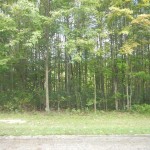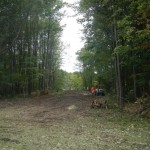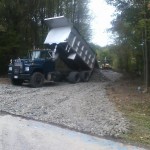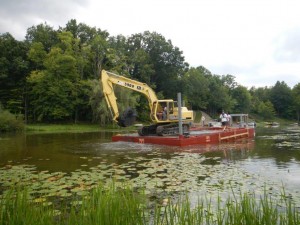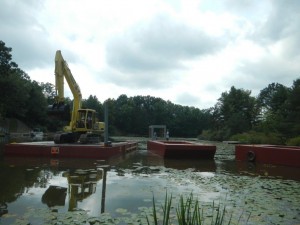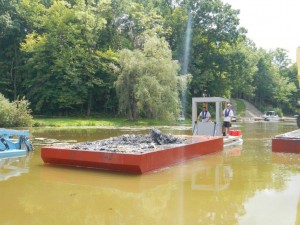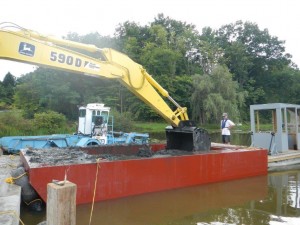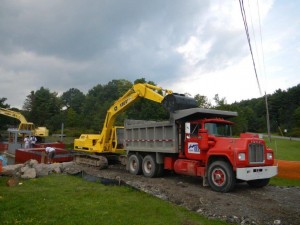Protecting our Beautiful Lake & Community
![]() by Tim Langer – Lake Sediment/Nutrient Control Subcommittee Chairman
by Tim Langer – Lake Sediment/Nutrient Control Subcommittee Chairman
You may have noticed the new “Love the Lake” logo that marks the articles and programs being developed by residents volunteering for the Sediment and Nutrient Control Subcommittee of the Lake Management Committee. You can see it included in this article. Our mission is to connect our community by 1) raising awareness about important issues, 2) offering good science based information, and 3) offering some easy ways to improve our community.
It is our hope that this logo reminds residents to BE LAKE RESPONSIBLE!
When weeds and algae in the lake become overgrown, we all look for help to find solutions. Our lake is not a public and natural resource of the State of Ohio, so it is up to us, the owners and residents of Roaming Shores to be responsible. We are the primary stewards of our great natural resource, Lake Roaming Rock. Please help us work together to protect our water for our enjoyment and that of future generations.
Given our private ownership and access to Lake Roaming Rock, our goal is to initiate programs to help residents actively manage their properties and proactively seek new and innovative solutions. Once we, the residents and owners, do all that we can to sustain these programs, outside funding, like government grants, can be more readily obtained to help us limit sediment and nutrients from our watershed.
When you see “Love the Lake” articles and programs, please participate. It is our hope that if we all contribute to the health of Lake Roaming Rock, our community will thrive. Please contact me (TimattheShores@gmail.com) if you would like to get involved, contribute or suggest an article, help with a program or have any questions. It is important that we all be responsible to help keep our lake and community beautiful.
I love our lake and I bet you do too.
Washing Your Boat – An alternative approach
![]() By Tim Langer – Lake Sediment/Nutrient Control Subcommittee Chairman
By Tim Langer – Lake Sediment/Nutrient Control Subcommittee Chairman
It is that time of year when we are all trying to get our boats cleaned and ready for winter. It seems like a rite of passage for winter to arrive, but a time to get our boats ready for storage. Did you know, soaps and detergents might add nutrients that promote algae blooms? They also destroy the external mucus layers that protect the fish from bacteria and parasites; plus they can cause severe damage to the gills. So, before you grab your old standby cleaner please consider the following;
- Rinse your boat frequently with fresh water to reduce the need for soaps and cleansers, help stop marine growth, and extend the life of the protective coating. Spot clean if needed.
- Use environmentally friendly cleaning products such as baking soda, vinegar, lemon juice, and borax when necessary. Use all cleaning products sparingly to minimize the amount discharged into the water.
- Use good old-fashion elbow grease.
- Use phosphate-free, biodegradable cleaners such as “Simple Green”. If you use detergents, use them sparingly.
- Avoid cleaning your boat dockside or in your driveway if you have a grate drain which goes to the lake. Wash your boat in an area that allows for infiltration of wash water, such as gravel or grass without a drain directly to the lake.
- Look for the words “phosphate-free and “biodegradable” on the cleaning products used.
- Never dispose of cleaning products by dumping near the lake.
With each of us taking a moment to consider our cleaning methods and products used, we each can BE LAKE RESPONSIBLE.
For more information or to print out a purchasing guide that contains what to look for on labels, toxic ingredients to avoid and how to clean with less please see the following link,
http://www.dbw.ca.gov/Environmental/CleanGreen/LessToxic.aspx
Next Stage for Dredging: Fisherman’s Cove
With our crew becoming more acclimated to the new dredging equipment in Plum Creek, plans are moving forward to begin digging in Fisherman’s cove. This cove was determined to have the most sedimentation, according to a study by Enviroscience. In order to remove spoils from this problem area efficiently, our crew put in a 350ft access road, the process only took a couple of days.
- Before
- During
- Almost Done
Lake Erie Ecosystem Priority (LEEP) Report
by R.D. Gainar, CEBS – Lake Management Committee Chairman
The Lake Erie Ecosystem Priority (LEEP) International Joint Commission recently published their summary report of key findings and recommendations. This US and Canadian commission’s function is to understand the sources of excess nutrients and the measures required in order to reduce them. The report can be found on our website (www.roamingshores.org) and is yet another important work provided in follow-up to the 2011 algal bloom, the largest in the history of Lake Erie. Like the Lake Erie Phosphorus Task Force Final Report, Lake Erie Phosphorus Task Force II, Strategic Plan for the Grand Lake St. Marys Restoration Commission, and several others (also on our website), this report is critical of the primary problem: flow of sediment and nutrients into our rivers and streams from the watershed and the current efforts to contain them in the fields.
The Commission writes: “Although eutrophication [a process akin to aging due to excessive nutrient enrichment] is again a serious threat to Lake Erie water quality, the sources and remedies are different from those of the 1960s and 1970s. While sewage plants still contribute some phosphorous to Lake Erie, diffuse runoff from rural and urban lands is a leading factor in eutrophication. Of particular concern is runoff of dissolved reactive phosphorous (DRP), which is highly bioavailable and thus a primary cause of renewed algae blooms. Addressing runoff requires strategies tailored to particular land uses, rather than controls on sewage plants alone.“
Among the Commission’s recommendations was that existing and planned incentive-based programs immediately shift to a preference for agricultural Best Management Practices that are most likely to reduce DRP by reducing the amount of phosphorous applied to fields, slowing the movement of water to the field drainage system, and detaining flows at field drainage outlets.
I encourage residents interested in understanding the facts of our water quality and clarity issues to read at least the executive summary of the LEEP Report. And remember, residents at Roaming Shores are a powerful political force especially when we voice reasonable requests to elected representatives. If you are interested in taking action to reduce HABs in our lake, please consider writing and calling your elected state representatives including Gov. Kasich and let them know that you support strong action to ensure that nutrients and sediment are controlled and limited so they do not enter our waterways.
Dredging Begins!
The day has finally come. This week, after many anxious months, the Army Corp of Engineers has given the RRA the green light to begin the dredging of Lake Roaming Rock!
While awaiting final approval, our crew worked hard to get the barges, equipment, and spoils site ready for the project. We were ready to begin around July 14th, but had to wait on several government agencies to issue permits and to give final approval to begin the project.
Dredging will be performed manually with an excavator situated on top of a spud barge. Dump scowls will be used to transfer the spoils to and from shore to be offloaded and transferred to our dump site.
Our crew is currently training in Plum Creek to become acclimated to the equipment. From there, they will move to the coves that have the most sedimentation according to the survey performed by EnviroScience.
We ask that you please keep your distance from the Dredging Equipment while our crew is working for their safety and yours.
(For larger images, please click on the photos)
July Lake Level Control Sub-Committee Meeting
Members present include Tim Langer, Walt Samson and Chairman Rick Gainar. Also present was Ed Baitt.
Meeting called to order at 2PM at the Association Office.
Items discussed:
- Due to the unplanned and extraordinary expense of the failed RRA Office building, it is anticipated that no funding will be possible for significant projects, including a siphon spillway, until 2017 at the earliest. Accordingly, it was decided that study and development of a siphon spillway be suspended for a period of one year.
- The sub-committee members will continue with 1) water sampling/testing projects including stream samples, deep-water samples, and samples from the model siphon spillway, and 2) building a consolidated database containing all official test results obtained to date from the many historic lake studies.
Regular monthly meetings are suspended until further notice.
Meeting was adjourned at 3:30PM
Now What With Geese
I hope you are enjoying your summer goose free. If so, your Lake Management Committee has done a great job limiting the harmful effects of goose droppings this year. If not, now is the time when adult geese are spreading their new wings and the goslings are taking their first flights and it is a perfect time to return back to heavy harassment with the geese. Geese are currently going through a “shift” looking for the spot where they are going to spend their time until the Fall so now is the time to be vigilant in chasing the geese off the property. As I am sure you have heard me say before, the key to being goose free is doing the right techniques right at the right time of the year. Below I provide a refresher of these techniques for this time of the year:
1) Never stop short of the geese leaving the property. Doing so can actually be detrimental to your program allowing the geese to feel like they “won the battle” by still being allowed to use your property even though they were harassed making it increasingly harder to harass them.
2) If there is water on the property, always chase the geese away from the water. Water to geese is safety and you want to remove any places where they feel safe in order to be effective.
3) Look for places to chase geese where they can feel trapped such as thick shrubbery, fences, corners of buildings, walls, etc. Making them feel trapped will give them a much more effective feeling of vulnerability which will help tremendously in keeping them from coming back to your property.
4) While any bangers, screamers, lights, decoys, sprays, motion sprinklers, etc. should have been sitting on the shelf not being used over the last few months, now is the time to pull those back out and again begin using them.
5) The two times to focus harassment efforts is at sunrise and sunset when the geese are going to/from feeding areas.
6) Stay consistent with your harassment. You don’t want to send mixed signals to the geese. The goal is to make them understand loud and clear they are not welcome on your property.
7) Once you get the geese flying, stick around for a few minutes to see if they are doing a big loop and coming back. If they do this you should be yelling at them as they are coming back waving your hands to keep them in the air. If there is a pond they are going to land on, throwing some rocks or sticks to make splashes on the water works great to keep them from landing on the water.
Following these tips will ensure you get rid of the geese quickly to allow you the rest of the summer goose free till the next “shift” on September 1st.
Geoff Westerfield
Assistant Wildlife Management Supervisor
Ohio Division of Wildlife
Ohio Lake Communities Association (OLCA) Meeting
by R.D. Gainar, CEBS – Lake Management Committee Chairman
Roaming Shores is a member of the Ohio Lake Communities Association (OLCA). This organization consists of 22 Ohio lake associations similar to ours and is one of our primary sources of current information and helpful experience on many common lake community problems and issues. Your Lake Management Committee Chairman and other Roaming Shores representatives attended the Spring 2014 OLCA meeting on April 23-24 at Willowdale Lake in North Canton, Ohio. In addition to an introduction to Willowdale, the newest lake in the OLCA community, we enjoyed the informative program that included topics involving legal issues, Ohio dam safety updates, fish management, human resources, dredging project updates, and office management issues and solutions.
In addition to the very useful information on these topics, I met and talked to six lake managers that are either mechanically dredging currently or are planning to start a mechanical dredging project in the near future. None of the lake communities reported that they are planning to hydraulically dredge their lakes. Lake Lakengren manager, Kevin Thorpe, has used the barge-dredging method, which we are planning to use here at the Shores, for over a year now and is very pleased with the results. He reports that the operation has proved much faster than originally expected and continues to be within budget. Lake Lakengren residents are very happy with the results so far and hope for similar outcomes when their coves are dredged. Director Ed Baitt included all improvements that Kevin had suggested in the Lake Depth Improvement Sub-Committee’s design and planning of our dredging project so we can expect a similar, favorable outcome.
Dredging at Grand Lake St. Mary’s
by R.D. Gainar CEBS – Lake Management Committee Chairman
Your Lake Management Committee is committed to evidence-based management practices but is also careful to consider comments made by residents. Questions continue to be raised comparing the dredging activities at Grand Lake St. Mary’s (GLSM) to our lake water quality activities by a very few residents who continue to favor and promote the former $2+ million plan to hydraulically dredge the shallows to “improve water quality”. However, evidence suggests otherwise so I contacted the ODNR to ask Mr. Scott D. Fletcher, Deputy Chief, Ohio State Parks & Preserves a few questions about the dredging activities at GLSM.
Q: At Roaming Shores all lake front property, with the exception of a few recreation lots owned by the homeowners association are privately owned. Is there any lake front property privately owned at GLSM’s? If so, are these property owners contributing to the program costs?
A: Grand Lake St. Mary’s has a substantial amount of privately owned shoreline. There was no direct cost to property owners; however, there was a significant amount of private money raised locally to support some demonstrations of promising technology, to develop strategic plans for remediation efforts and to provide for public education.
Q: I am confused by the relationship between your use of dredging and chemical treatment to control phosphorus. Your consultants at TetraTech advise that dredging should only be used in strategic places, such as mouths of tributaries where there is significant nutrient buildup because the cost disparity of dredging as compared to chemical treatments ($17,894/ha vs. $564/ha). It would seem to me more efficient and effective for you to skip dredging altogether and instead invest those funds in chemical treatment. Even if you dredge the entire lake in your attempt to control internal release of phosphorus, you would still need to deal with DRP coming in from the watershed. Are you dredging primarily to increase the lake depth as opposed to controlling internal phosphorus release?
A: Excellent questions. Regarding dredging, the purpose of the program is actually to maintain navigation for safe boating. This is dictated by the funding source (gas tax) that’s used to operate the dredging program. As such our efforts focus on channels, the mouths of navigable streams and other areas that primarily support boating. The minimal benefit in reducing nutrients in the lake as a whole is a net positive one, but not the focus of the dredging program. If were using dredging to address the nutrient issue we would probably focus on the deepest portion of the lake and not the shallow areas where most of the work is currently done.
Q: What percentage of the lake has currently been dredged?
A: Off the cuff I would estimate that the percentage of the lake that is dredged in any single year is probably less than 1%. A program that includes three dredges that generates about 300,000 cu. yds. of material on the 12,500 acre lake is a limited, targeted program.
Q: If you could do only one thing to improve the water quality at GLSM’s
what would that be?
A: We would stop the inflow of excess nutrients to the lake. Controlling the watershed is the key to remediating the conditions
in the lake.
Lake Management Plan
by R.D. Gainar, CEBS
LMC Chairman
For those of you who were unable to attend the Lake Depth Control Sub-Committee meeting on October 28, 2013 describing the Dredge Plan, you also missed a presentation and discussion of our Lake Management Plan. The following are highlights of the Lake Management Plan:
The first step of the Plan involved reorganizing the Lake Management Committee into separate groups to allow more residents to participate and to focus attention on phosphorus and nutrients, the primary cause of poor water quality. The heart of our Lake Management Plan to improve water quality involves the work of three committees. The Lake Level Control Sub-Committee’s focus is on phosphorus that is internally released in our lake while the Lake Sediment/Nutrient Control Sub-Committee’s focus is on phosphorus transported into our lake from the watershed. A third committee, the Lake Depth Improvement Sub-Committee, in addition to dredging our shallow coves, will excavate sediment traps in the back of major coves. These traps will limit the amount of sediment from coming into the lake.
A major component of the Lake Management Plan is to organize a “clean up your own backyard” campaign to educate residents on things they can do to prevent nutrients from entering the lake. It is unreasonable to request nutrient limiting actions outside our community unless we are first willing to do all we can to limit transport of nutrients into our lake from our own properties surrounding the lake. Another component of this Plan is to organize a campaign to lobby our elected state and federal leaders in support of bills that seek to curb fertilizer runoff in our watershed, improve water quality and nutrient management of agricultural operations, and other legislation such as Ohio Senate Bill 150. You will hear more about these programs this summer.
Our lake water-testing program will continue providing valuable data such as phosphorus, dissolved oxygen and clarity measurements to our consultants and committees so they may continue to made responsible, evidenced-based decisions. Testing for algal toxins will resume again next summer as these threats continue to plague all lakes in Ohio.
I think you will agree that much has been accomplished in the short time these Lake Management Committees have been working. However, there is much to do. So if you would like to learn about your lake and participate in its improvements, you are encouraged to join your Lake Management Committee.
